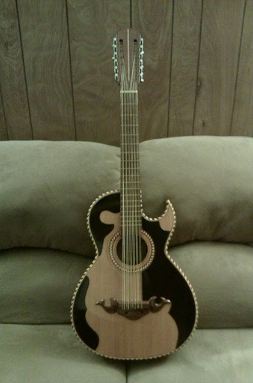Bajo sexto, also known as ‘sixth bass,’ is a stringed instrument that originated from Mexico. It is a part of the guitar family with twelve strings in six double courses. Bajo sexto is closely related to the instrument called bajo quinto, or the ‘fifth bass,’ with ten strings in five double courses. This instrument is played similarly to the guitar wherein the performer holds the strings against its frets located on the Bajo sexto’s fingerboard, while the right-hand is strumming or plucking the strings. In the modern melodic or chordal style of playing this instrument, the player uses a pick.
There were few written sources about the bajo sexto, and most encyclopedias and music dictionaries did not mention the instrument. In fact, the history of this instrument is unclear. When researchers tried to trace back the background of the instrument, Professor Guillermo Contreras from Mexico’s Consevatorio Nacional de Musica (National Conservatory Music) stated that there is a chance that the bajo quinto is a descendant of the instrument chitarra battente. During the 17th and 18th centuries, artisans from Mexico have built several types of double-stringed instruments with about three to eight courses. These instruments were said to be influenced by their Spanish ancestors. Some of the descendants of the bajo sexto are Guitarra Septima, Quinta huapanguera, bandolon, jarana jarocha, and concheras.
By the end of the 19th century, the manufacturing of the bajo sexto began to head northwards. As well as that, it also became one of the notable instruments used in weddings and dances like the Bailes de regalos, which was popular from the years 1870 to 1930. Additionally, the bajo sexto was also used as an accompaniment of small tom-tom drums. In the 1930s, accordions and the bajo sexto were among the chosen instrument that was used during the rise of conjunto music. At this time, the bajo sexto primarily functioned as a bass instrument that provides a strong rhythm to the solo accordion.
From the 1940s to the year 1950, several instruments were added to the conjunto ensemble. These include the string bass, electric bass, and drums. With the entrance of these basses and drums, bajo sexto was freed from being the rhythmic bass in the ensemble. Since then, Bajo players began experimenting with the instrument’s chords, melody, and counter-rhythms. As the popularity of the conjunto rises, musicians from Northern Mexico and Texas began to use the bajo sexto and play other forms of music. Some of these music forms were the norteño music of Northern Mexico and the Tejano music, a popular music style with influences from Mexico, Europe, and the United States. The manufacturing of bajo sextos and bajo quintos in the 21st century is mostly famous in countries like Texas, Mexico, and California.
Moreover, although the bajo quinto looks like a twelve-stringed guitar, its body is usually deeper, with a shorter neck where the ten frets are located. Meanwhile, guitars with about twelve to fourteen strings usually have thicker strings than the bajo quinto. Older bajos tend to have a larger body, in comparison to the modern ones, which looks like a guitar. In addition, modern bajos frequently have a cutaway in their upper bout adjacent to its neck. With this cutaway, performers have easy access to the play the higher position on the neck.
The bajo sexto is tuned an octave below the guitar. Thus, its body is not large enough to resonate with the lowest E. The performers usually remove the instrument’s sixth course, playing only the ten strings in five courses. Also, luthiers then began leaving off the low E-course during the Bajo sexto’s construction, producing only five courses instrument- also known as the bajo quintos. Bajo sextos were usually tuned in fourths, or what the guitarists called as fourths tuning. In this tuning, the lower three courses are tuned at, the higher octave, while the upper three courses were tuned double at the unison.
Some notable players of the instrument were Max Baca from the band Los Texmaniacs, Ryland Peter Cooder, Paulino Bernal, and Homero Guerrero De La Cerda of the Los Cadetes de Linares band.

